The Healthy City Constructed by Regional Governance and Urban Villages: Exploring the Source of Xiamen’s Resilience and Sustainability
Abstract
1. Introduction
1.1. Study Background
1.2. The Resilience of Cities
1.3. Study Framework and Hypotheses
2. Material and Method
2.1. Study Area
2.2. Study Steps and Contents
3. Results
3.1. The Outward Expansion and Connection of Islands: Land Reclamation, Bridges, Port Infrastructure
3.1.1. Land Reclamation
3.1.2. Bridges and Port Infrastructure
3.2. Xiamen-Centered Regional Governance: The Urban Village in the Bay Area
3.2.1. The Process of Transforming Traditional Villages into Urban Villages
3.2.2. The Spatial Characteristics of Urban Villages in the Region Were Studied
3.3. The Role Positioning of Urban Villages
3.3.1. Residential Community Type
3.3.2. Tourism Consumption Type
3.4. The Integration of Old and New in the Environment of Urban Villages
“This place used to be a rural area, later, many people from other places came here, locals built many houses for rent”(XA9)
“The village is growing generation by generation, the house is not enough to live in, they began to build buildings, here are most of the villagers themselves in living”(BZ30)
“Before the COVID-19 epidemic, the population of XA reached nearly 200,000, but now it is nearly half of that. After the epidemic, employment is not good, the rent has also increased several times, and the salary has not risen much, many people have left. In recent years, no one has built a house”(XA7)
3.5. The Healthy Appearance of Urban Development
3.5.1. Harmonious Development of Old and New Environment
“The construction of unfinished buildings in the village was almost suspended for five or six years. During that time, the height of the buildings was limited by the policy. The part of the unfinished buildings that exceeded the height was demolished, and the construction has not continued since the suspension”(XA1)
“Many of these unfinished buildings are changed into parking spaces for rent, a month CNY200–300, meet and negotiate with each other, otherwise this house empty’s loss is too big”(XA1, XA2, XA9)
“We fellow townspeople often gather in this courtyard to have meals and play the games of our hometown. We get along very well”(XA1)
“We also play cards with the landlord and share the vegetables I grow in the yard”(XA15)
“The empty space in front of Zhengshun Palace has been renovated by the government, and there are many people here every day. Many people take their children, chat and play cards”(XA6)
“In the past two years, the government’s renovation has improved the environment of the whole community, and there are more places for leisure”(WL28)
“WL’s talent apartments have a great environment and are very cheap”(WL29)
3.5.2. Traditional Architecture Helps Transform Urban Villages
“DS used to be a small village. I didn’t even know it existed when I went to school nearby. Now it has developed, with a growing number of tourists and shops”(DS24)
“I come here to open my shop because I feel the cultural atmosphere is very good and the house is also very characteristic. In these two years, I feel that more and more people travel”(DS22)
“Nowadays, more and more people come to DS for tourism. Many houses in the village have been rented out for opening stores. Recently, several new restaurants have been opened.”(DS25, DS26)
“There are many ancient houses in the village, and some of them have been changed into experience centers. At present, not many people in the village know about them, but these buildings are left. In case there are more people in the future and the government increases investment, HT can really develop tourism.”(HT37)
“The government has renovated these houses in the hope that someone will come and set up shop in the future, in case tourism really develops”(HX33)
“Look at the temple fair held today. A lot of people have come. Maybe it will really become a famous scenic area like Gulangyu Island (a famous tourist attraction in Xiamen) under the government’s planning”(HX35)
“The vacant land over there is now under construction for hotels and other projects to prepare for the future development of tourism”(BZ27)
4. Discussion
4.1. Sources of Resilience in Healthy Cities
4.1.1. Resistance and Absorption: Development Anchor Point with High Recognition
4.1.2. Expand: Efficiency Space to Improve System Effectiveness
4.1.3. Co-Construction: Reserve Elastic Space for Transformation
4.2. Sustainability of Healthy Urban Development
4.2.1. The Inclusiveness of Multiculturalism
4.2.2. Cultural Turn to Promote Sustainable Development
4.3. Referability and Limitations of the Study
5. Conclusions
Supplementary Materials
Author Contributions
Funding
Institutional Review Board Statement
Informed Consent Statement
Data Availability Statement
Conflicts of Interest
Correction Statement
References
- Crow, G. Urban Village. In International Encyclopedia of Human Geography; Kitchin, R., Thrift, N., Eds.; Elsevier: Oxford, UK, 2009; pp. 101–105. [Google Scholar]
- Gans, H.J. Urban Villagers; Simon and Schuster: New York, NY, USA, 1982. [Google Scholar]
- Kitchin, R.; Thrift, N. International Encyclopedia of Human Geography; Elsevier: Amsterdam, The Netherlands, 2009. [Google Scholar]
- Wang, C. Urban village on a global scale: Diverse interpretations of one label. Urban Geogr. 2022, 43, 184–205. [Google Scholar] [CrossRef]
- Lueder, C. Urban villages and informal settlements as protagonists of urban futures. Urban Des. Int. 2018, 23, 4–21. [Google Scholar] [CrossRef]
- Wei, C.; Tong, D.; Yuan, Y.; Chu, J. Research Hotspots and Regional Differences of Urbanizing Village:Bibliometric Analysis Based on CiteSpace. Reg. Res. Dev. 2022, 41, 68–74. [Google Scholar] [CrossRef]
- Yan, X.; Zhou, R. A Study on the Coordination of Urban-Rural Relations in Rapid Urbanization Areas: A Case Study of the Transformation of “Urban Villages” in Guangzhou. Urban Plan. 2004, 30–38. [Google Scholar]
- Cheng, D. Study on the Path and Strategy of Urban Renewal Planning in the Old Urban Areas of Small and Medium-Sized Cities under the Concept of Action Planning. China Anc. City 2025, 39, 11–20. [Google Scholar] [CrossRef]
- Gan, X. Tracing and Analyzing Urban Informal Settlements and Employment from the Lens of Informality. Mod. Urban Res. 2023, 96–102. [Google Scholar]
- Wu, F.; Zhang, F.; Webster, C. Informality and the Development and Demolition of Urban Villages in the Chinese Peri-urban Area. Urban Stud. 2013, 50, 1919–1934. [Google Scholar] [CrossRef]
- Ye, Y.; Xu, M.; Tian, L.; Gao, L.; Liu, W.; Chen, Y.; Wang, J.; Wang, S.; Yin, Z. Urban informal development and governance. Urban Plan. 2020, 44–49. [Google Scholar]
- Duan, W.; Wei, L.; Huang, Y.; Cui, Z. Inclusive Socio-Spatial Transformation: A Study on the Incremental Renovation Mode and Strategy of Residential Space in Beijing’s Urban Villages. Buildings 2025, 15, 1755. [Google Scholar] [CrossRef]
- Tao, L. The Hybrid Symbiosis Between the City and the Boundary of the Urban Village—Take the Second Yuer Village, Shekou, Shenzhen and Its Surroundings as an Example. Master’s Thesis, Tamkang University, New Taipei City, Taiwan, 2018. [Google Scholar]
- Qu, L.; Oostrum, M.V.; Liu, J.; Li, Y.; Yang, Q. Mapping Atlas of Shenzhen—Urban Villages; Delft University of Technology: Delft, The Netherlands, 2017. [Google Scholar]
- Zhong, M.; Lin, K.; Tang, G.; Zhang, Q.; Hong, Y.; Chen, X. A Framework to Evaluate Community Resilience to Urban Floods: A Case Study in Three Communities. Sustainability 2020, 12, 1521. [Google Scholar] [CrossRef]
- Zheng, L. Unfinished Modernity: “Five Men” and the Aesthetics of Urban Villages in the Pearl River Delta. Mod. Chin. Acad. J. 2024, 101–111. [Google Scholar]
- Shi, L.; Lamb, Z.; Qiu, X.; Cai, H.; Vale, L. Promises and perils of collective land tenure in promoting urban resilience: Learning from China’s urban villages. Habitat Int. 2018, 77, 1–11. [Google Scholar] [CrossRef]
- Qi, Z.; Gao, J.; Wang, L.; Yan, Z.; Chen, H. Drawing a New Picture of Egret Island—“Xiamen Practice” of Xi Jinping’s Thought on Ecological Civilization: Xinhua News Agency; 2024-02-21. Available online: https://baijiahao.baidu.com/s?id=1791438476914487757&wfr=spider&for=pc (accessed on 6 July 2025).
- Li, Y.; Lu, S. The Development of Xiamen City under the Influence of Seawall Construction and Sea Reclamation. Guangdong Landsc. Archit. 2017, 39, 52–58. [Google Scholar]
- Ruijun, G. Research on the Shape and Change of Spatial Value in the Evolution of Xiamen Malo. Master’s Thesis, Huaqiao University, Xiamen, China, 2022. [Google Scholar]
- Lin, X.; Xu, M.; Zheng, L.; Chen, X.; Zheng, H. Exploration of Urban Village Modernization Governance in Major Cities Based on the “Four Communities” Development Goals: A Case Study of Xiamen. Urban Dev. Res. 2024, 31, 106–114. [Google Scholar]
- Yao, Z.; Tian, L.; Fan, C.; Zhou, L. Research on the Renewal Model of Existing Space from the Perspective of Public Rental Housing Supply: Planning Thoughts on the Renovation of Urban Villages in Xiamen. J. Urban Plan. 2018, 88–95. [Google Scholar] [CrossRef]
- Yu, X.; Zhao, Z. Syntactic Analysis of the Development and Evolution of the Core Area of Xiamen Port and Thoughts on its Extension. J. Archit. 2018, 174–178. [Google Scholar]
- Hu, J.; Liu, J.; Dai, A.; Wang, X. A Preliminary Study on the Protection Strategies of Cultural Heritage in “Urban Villages”: A Case Study of Nijin Society in Wutong Village, Xiamen Island. Chin. Foreign Archit. 2017, 44–48. [Google Scholar] [CrossRef]
- Lin, P. The Renewal Strategy of Self-built Houses in Urban Villages from the Perspective of Heritage Protection: A Case Study of Xiagang Area in Xiamen City. Urban Archit. Space 2023, 30, 66–68. [Google Scholar]
- Wen, L. The Urban Village of Cultural Tourism and Business Development Has Been Transformed into a Modern Community. Xiamen Daily. 2024. Available online: https://link.cnki.net/doi/10.28890/n.cnki.nxmrb.2024.002677 (accessed on 6 July 2025).
- Cai, Z. Build a World-Class Tourism and Leisure City from a Higher Starting Point. 2024. Available online: https://link.cnki.net/doi/10.28890/n.cnki.nxmrb.2024.003763 (accessed on 6 July 2025).
- How did Xiamen Achieve a Major Transformation of Its Urban Villages? Sina News. 2025. Available online: https://news.sina.com.cn/zx/gj/2025-04-14/doc-inetcqhu8789308.shtml (accessed on 6 July 2025).
- Harvey, D. Justice, Nature and the Geography of Difference; Blankwell: Oxford, UK, 1996. [Google Scholar]
- Odum, E.P. Ecology and Our Endangered Life-Support System; Sinauer Assoc. Inc.: Sunderland, MA, USA, 1989. [Google Scholar]
- Odum, E.P. Fundamentals of Ecology; Saunders: Philadelphia, PA, USA, 1971. [Google Scholar]
- Peter Calthorpe, W.F. The Regional City: Planning for the End of Sprawl USA.; Island Press: Fort Lauderdale, FL, USA, 2001. [Google Scholar]
- Common, M.; Perrings, C. Toward an Ecological Economics of Sustainability. Ecol. Econ. 1992, 6, 7–34. [Google Scholar] [CrossRef]
- Lin, C.; Xin, T.; Shengbiao, C. The judgment of the destination of “Urban Villages” under Philosophical thinking: From Extinction to Rebirth. Planner 2017, 33, 134–139. [Google Scholar]
- Tsai, S.-C.; Lee, S.-H. Disaster-Resilient Communities on Flood Plains and Their Agricultural Regeneration: A Case Study in Meinong Plain, Taiwan. Water 2022, 14, 1736. [Google Scholar] [CrossRef]
- Liao, K.-H. The Dynamics and Resilience of River Cities as Coupled Human-Natural Systems; University of Washington: Seattle, WA, USA, 2012. [Google Scholar]
- Wang, H.; Zou, Z.; Tsai, S.C. Exploring Environmental Restoration and Psychological Healing from Perspective of Resilience: A Case Study of Xinglin Bay Landscape Belt in Xiamen, China. Int. J. Environ. Sustain. Prot. 2022, 2, 44–54. [Google Scholar] [CrossRef]
- Xiude, L. Research on Digital Modeling and Environment in the Bay Area of Fujian Province Xiamen Bay; Ocean Press: Beijing, China, 2009. [Google Scholar]
- Huang, S. Changes in Xiamen’s Sea Areas: Huge Changes in Our Home Xiamen, China: Xiamen Evening News; 2014 [cited 2023 12/21]. Available online: https://mp.weixin.qq.com/s?__biz=MzA4ODE2MDEzMg==&mid=200830249&idx=1&sn=3f8b2fb60e48447723ab65125490f9fd&chksm=1e22afc2295526d4dcef6b75a30f2063c7f68b18efcfe6da610f693f54f2b2cd5aa7ef3c83c1&scene=27 (accessed on 6 July 2025).
- Jingwei, B.; Sheng, Z. Research and Practice of Contemporary Urban Transportation Planning: A Case Study of Xiamen City; China Architecture & Building Press: Beijing, China, 2010. [Google Scholar]
- Lin, T.; Li, X.; Zhang, G.; Zhao, Q.; Cui, S. Analysis of the Characteristics of Urban Spatial Expansion and Its Influencing Factors in Xiamen Island. Acta Geogr. Sin. 2010, 65, 715–726. [Google Scholar]
- Lin, R. Research on the Urban Development Strategy of Xiamen: Towards a Modern and International City with High Quality and High Appearance Standards; Xiamen University Press: Xiamen, China, 2022. [Google Scholar]
- Ding Guoyan, L.J. Overview of Urban Development in the Golden Triangle of Southern Fujian: Social Sciences; Academic Press: Cambridge, MA, USA, 2019. [Google Scholar]
- Bi, X.; Liu, F.; Pan, X. Coastal Projects in China: From Reclamation to Restoration. Environ. Sci. Technol. 2012, 46, 4691–4692. [Google Scholar] [CrossRef] [PubMed]
- Zhu, G.; Zhao, P.; Zhang, L.; Li, X.; Ding, W.; Yu, H.; Zhang, N.; Yang, S.; Zhang, C.; Xie, Z. Territorial spatial suitability assessment and optimization of coastal port reclamation in China. Ocean. Coast. Manag. 2024, 254, 107189. [Google Scholar] [CrossRef]
- Li, Y.; Qiu, J.; Li, Z.; Li, Y. Assessment of Blue Carbon Storage Loss in Coastal Wetlands under Rapid Reclamation. Sustainability 2018, 10, 2818. [Google Scholar] [CrossRef]
- Yan, F.; Wang, X.; Huang, C.; Zhang, J.; Su, F.; Zhao, Y.; Lyne, V. Sea Reclamation in Mainland China: Process, Pattern, and Management. Land Use Policy 2023, 127, 106555. [Google Scholar] [CrossRef]
- Yue, Q.; Zhao, M.; Yu, H.; Xu, W.; Ou, L. Total quantity control and intensive management system for reclamation in China. Ocean. Coast. Manag. 2016, 120, 64–69. [Google Scholar] [CrossRef]
- Compiled by Xiamen Jimei District Chronicles and Local Chronicles Compilation Committee. Local Chronicles of the People’s Republic of China, Fujian Chronicles, Xiamen Jimei District Chronicles; Zhonghua Book Company: Beijing, China, 2013. [Google Scholar]
- Sengupta, D.; Townsend, D.; Brown, S.; Haigh, I.D.; Townend, I. Pride and prejudice of the anthropocene coasts. Ocean. Coast. Manag. 2025, 262, 107579. [Google Scholar] [CrossRef]
- Xu, Z. A Brief Analysis of the Urban Spatial Development of Xiamen Island. Fujian Constr. Technol. 2012, 53–57. [Google Scholar]
- Shuxia, J. Xiamen City Annals; Local Chronicles Publishing House: Beijing, China, 2004. [Google Scholar]
- The Xiamen Haicang Bridge, Which is 6.3 Kilometers Long, is the First Three-Span Continuous Fully Floating Steel Box Girder Suspension Bridge in Asia 2025. Available online: https://baijiahao.baidu.com/s?id=1827006856948259200&wfr=spider&for=pc (accessed on 18 June 2025).
- Bureau XMPaA. Xiamen Planning Atlas; China Hanlin Publishing Company: Hong Kong, China, 2001. [Google Scholar]
- Tu, F.W. Geographical Names of Xiamen City; Fujian Provincial Map Publishing House: Fuzhou, China, 2001. [Google Scholar]
- Bureau, X.T. Selected Tour Guide Scripts for Xiamen; Tourism Education Press: Beijing, China, 2014. [Google Scholar]
- Committee CbtXUCAC. Xiamen Urban Construction Annals; China Statistics Press: Beijing, China, 2000. [Google Scholar]
- Bo, L. With the Implementation of a Plan Worth over 100 Billion Yuan, How Can the Old Port Area Be Upgraded and Reborn. Xiamen Daily. 2022. Available online: https://link.cnki.net/doi/10.28890/n.cnki.nxmrb.2022.002577 (accessed on 6 July 2025).
- Wang, W. Taking the “Bay Area” as a new carrier for the development of the living environment in coastal cities: A Case Study of Xiamen. Planner 2006, 11–13. [Google Scholar]
- Li, X. Research on the Spatial Transformation of Urban Villages from the Perspective of New Endogenous Development. Master’s Thesis, Huaqiao University, Xiamen, China, 2023. [Google Scholar]
- He, Z.; Cai, L.; Hou, Z. Modern Governance of Urban Villages in Xiamen: Process, Trend and Practice 2025. Available online: https://mp.weixin.qq.com/s/CjyNvqICt_ZFI-UkrBf2iA (accessed on 6 July 2025).
- Lv, Y. Xiamen Urban Villages: Loss and Rebirth in the Cracks of Urban Development 2016. Available online: https://mp.weixin.qq.com/s/fJgiQUCqjKIO93S8Ddpssg (accessed on 6 July 2025).
- Chen, B. A Historical Investigation of the Evolution of Spatial Forms in Traditional Living Blocks. Master’s Thesis, Huaqiao University, Xiamen, China, 2022. [Google Scholar]
- Peng, Z. Urbanization and Counter-urbanization: A New Type of Two-way Convection Relationship—Taking Zengcun Village in Xiamen City as an Example. J. South-Cent. Minzu Univ. 2019, 39, 69–73. [Google Scholar]
- Chen, Z. Practice and Implications of Urban Village Renovation in Xiamen: Discussion on Planning Ideas for Urban Village Renovation under the Background of Urban Transformation and Development. Beijing Plan. Constr. 2024, 86–90. [Google Scholar]
- Zheng, L. The “Renewal Story” of Urban Villages in Xiamen 2024. Xinhua News Agency. Available online: https://www.xinhuanet.com/local/20240711/4cda8827fdb94e76b9728729742c3197/c.html (accessed on 6 July 2025).
- Zengbing, W.; Gang, Y. The Story of Chen Jiageng’s Prosperity; China Fujian Education Press: Fujian, China, 1985; pp. 15–16. [Google Scholar]
- Wu, D.; Liang, Z. The “Building Name Culture” of Century-old Universities—A Study on the “Jiageng Architecture” of Xiamen University and Jimei University. J. Jishou Univ. 2021, 42, 28–36. [Google Scholar] [CrossRef]
- He, L.; Tan, H. The Long-term Impact of Major Epidemic Events on the Labor Market: Based on an Examination of the Trend Characteristics of the Global Labor Market after the Epidemic. Contemp. Econ. Res. 2024, 70–80. [Google Scholar]
- Our City has Established a Unified Renewal Standard for Urban Villages: The People’s Government of Xiamen City. 2024. Available online: https://www.xm.gov.cn/jdhy/rdhy/202401/t20240124_2811814.htm (accessed on 6 July 2025).
- Lin, Y.; Liu, J. Research on the Innovative Model of Modern Governance in Urban Villages: A Case Study of Haicang District, Xiamen City. The 2024 Academic Annual Conference of the Architectural Society of China; Shaoxing, Zhejiang Province, China. 2024. Available online: https://link.cnki.net/doi/10.26914/c.cnkihy.2024.072652 (accessed on 6 July 2025).
- Thinh, N.K.; Kamalipour, H.; Peimani, N. Morphogenesis of forgotten places: A typology of villages-in-the-city in the Global South. Habitat Int. 2024, 153, 103184. [Google Scholar] [CrossRef]
- Zhao, J.; Zhu, J. Cultural reinvention or cultural erasure? A study on rural gentrification, land leasing, and cultural change. Habitat Int. 2025, 155, 103233. [Google Scholar] [CrossRef]
- Lee, Y.; Reina, V.J. Gentrification and neighbourhood satisfaction: A study of Philadelphia. Urban Stud. 2025, 62, 828–850. [Google Scholar] [CrossRef]
- Wu, Y.; Zhang, Y. Formal and Informal Planning-Dominated Urban Village Development: A Comparative Study of Luojiazhuang and Yangjiapailou in Hangzhou, China. Land 2022, 11, 546. [Google Scholar] [CrossRef]
- Fulong, W.U.; Shenjing, H.E. Changes in Traditional Urban Areas and Impacts of Urban Redevelopment: A Case Study of Three Neighbourhoods in Nanjing, China. Tijdschr. Voor Econ. En Soc. Geogr. 2010, 96, 75–95. [Google Scholar] [CrossRef]
- Bruce, S. God Is Dead: Secularization in the West; Wiley-Blackwell: Hoboken, NJ, USA, 2002. [Google Scholar]
- Haid, C.G.; Hilbrandt, H. Urban Informality and the State: Geographical Translations and Conceptual Alliances. Int. J. Urban Reg. Res. 2019, 43, 551–562. [Google Scholar] [CrossRef]
- Chen, J.; Qi, K. Urban regeneration with the intervention of industrial transformation and curatorial ideas—A Case Study of Dafen Village, Shenzhen. Telemat. Inform. Rep. 2021, 1, 100004. [Google Scholar] [CrossRef]
- Fabbricatti, K.; Boissenin, L.; Citoni, M. Heritage Community Resilience: Towards new approaches for urban resilience and sustainability. City Territ. Archit. 2020, 7, 17. [Google Scholar] [CrossRef]
- Zheng, L.; Huang, T. Making Up for the Shortcomings of Modern Urban Governance: A Frontline Observation of Urban Village Governance in Xiamen: Xinhua News Agency. 2024. Available online: https://baijiahao.baidu.com/s?id=1829437520124972234&wfr=spider&for=pc (accessed on 6 July 2025).
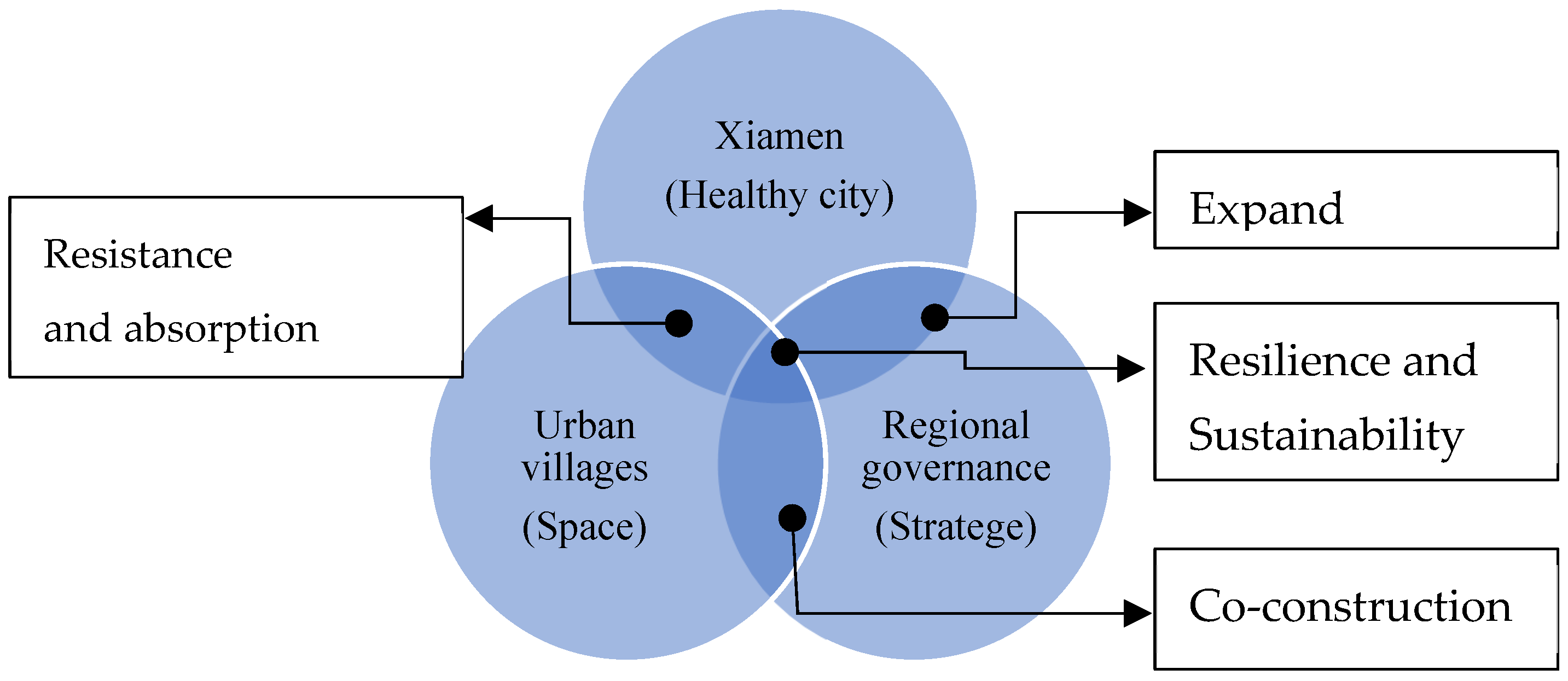
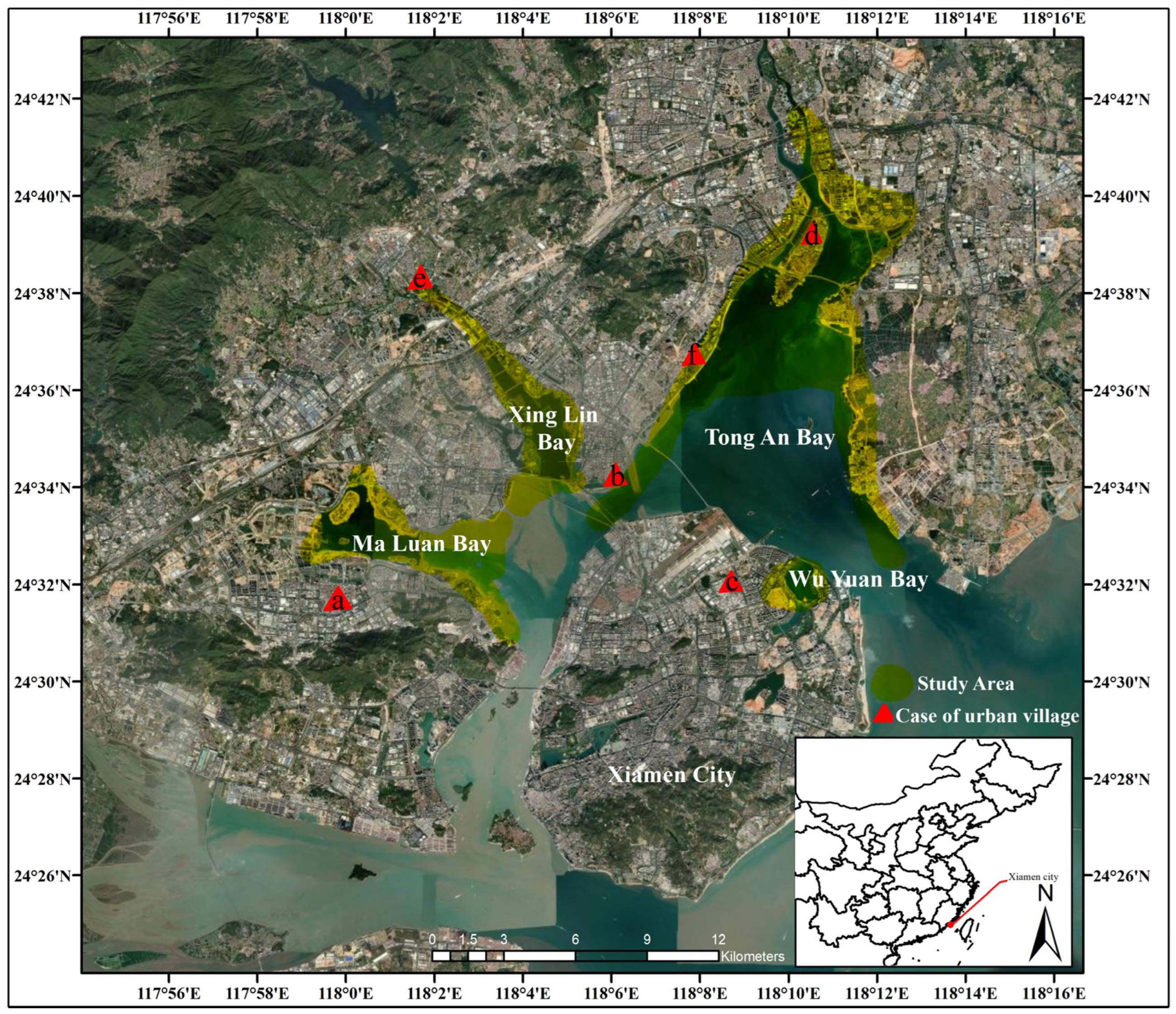
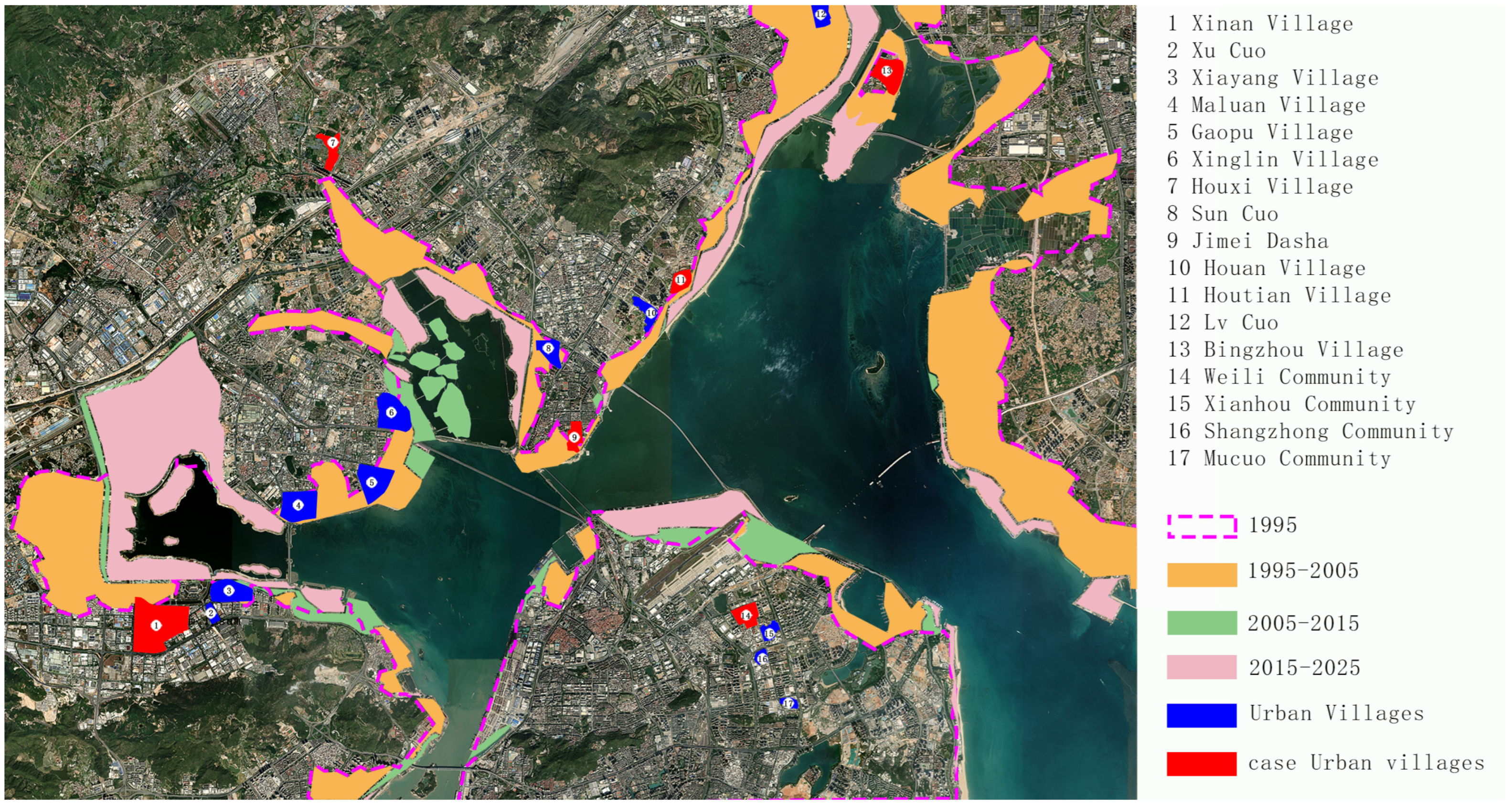
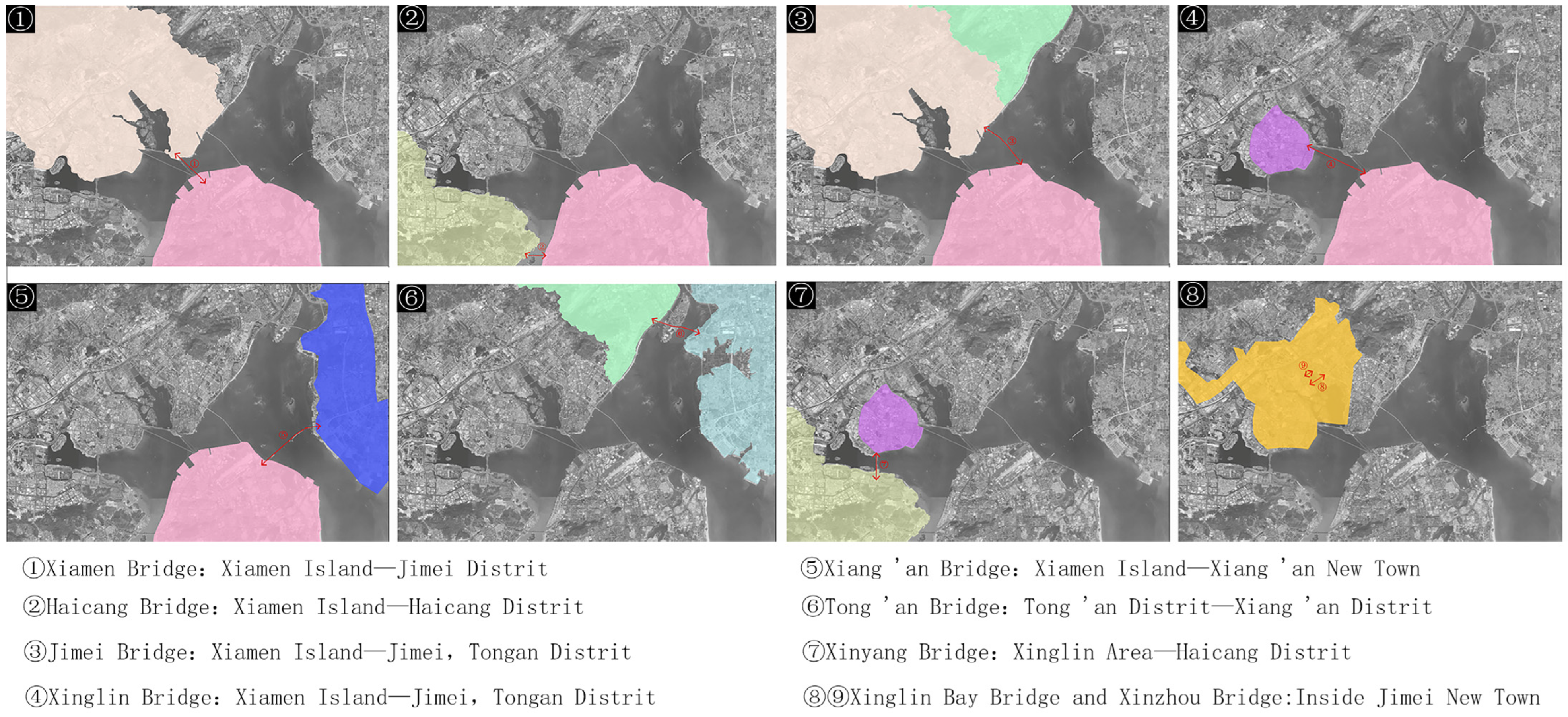

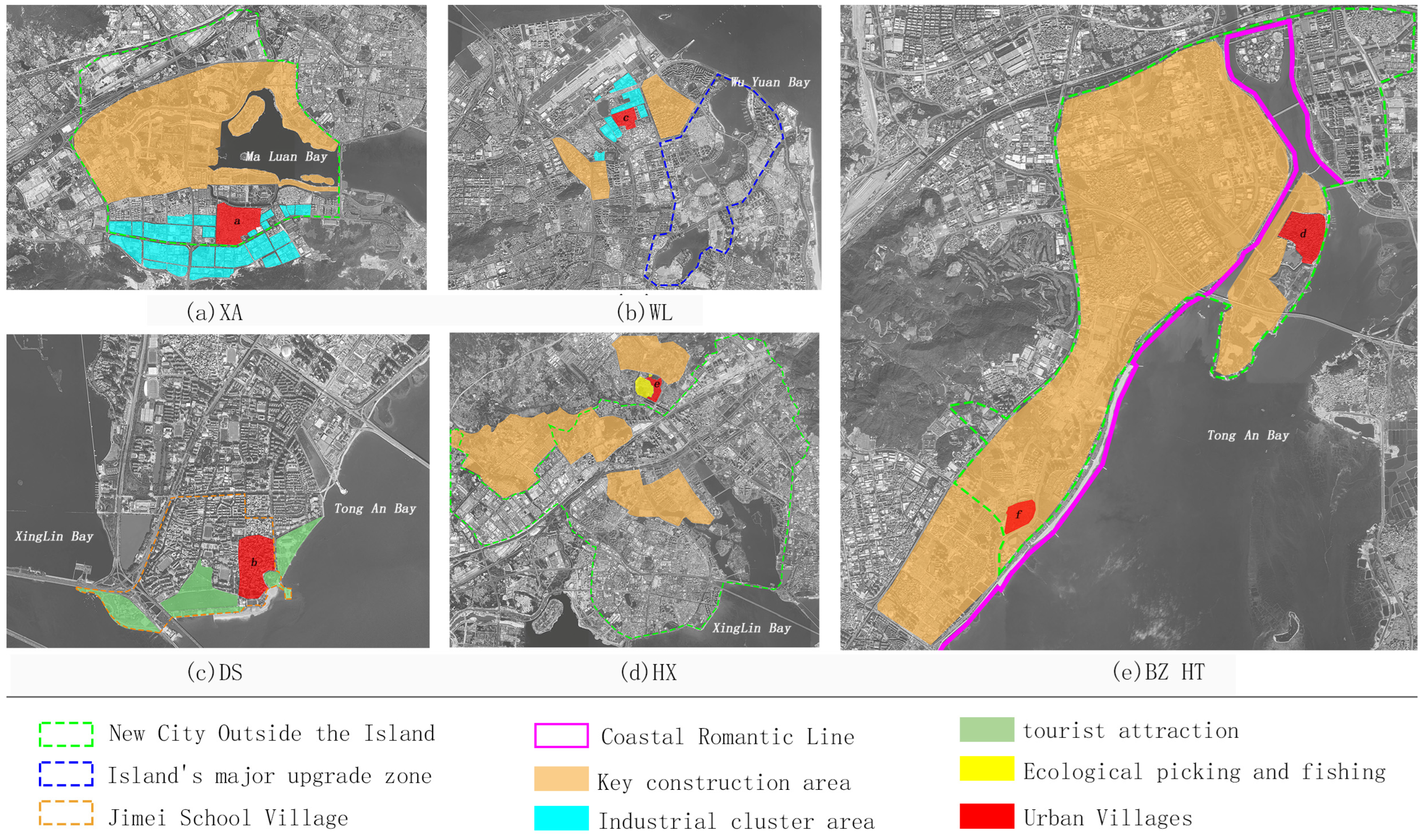
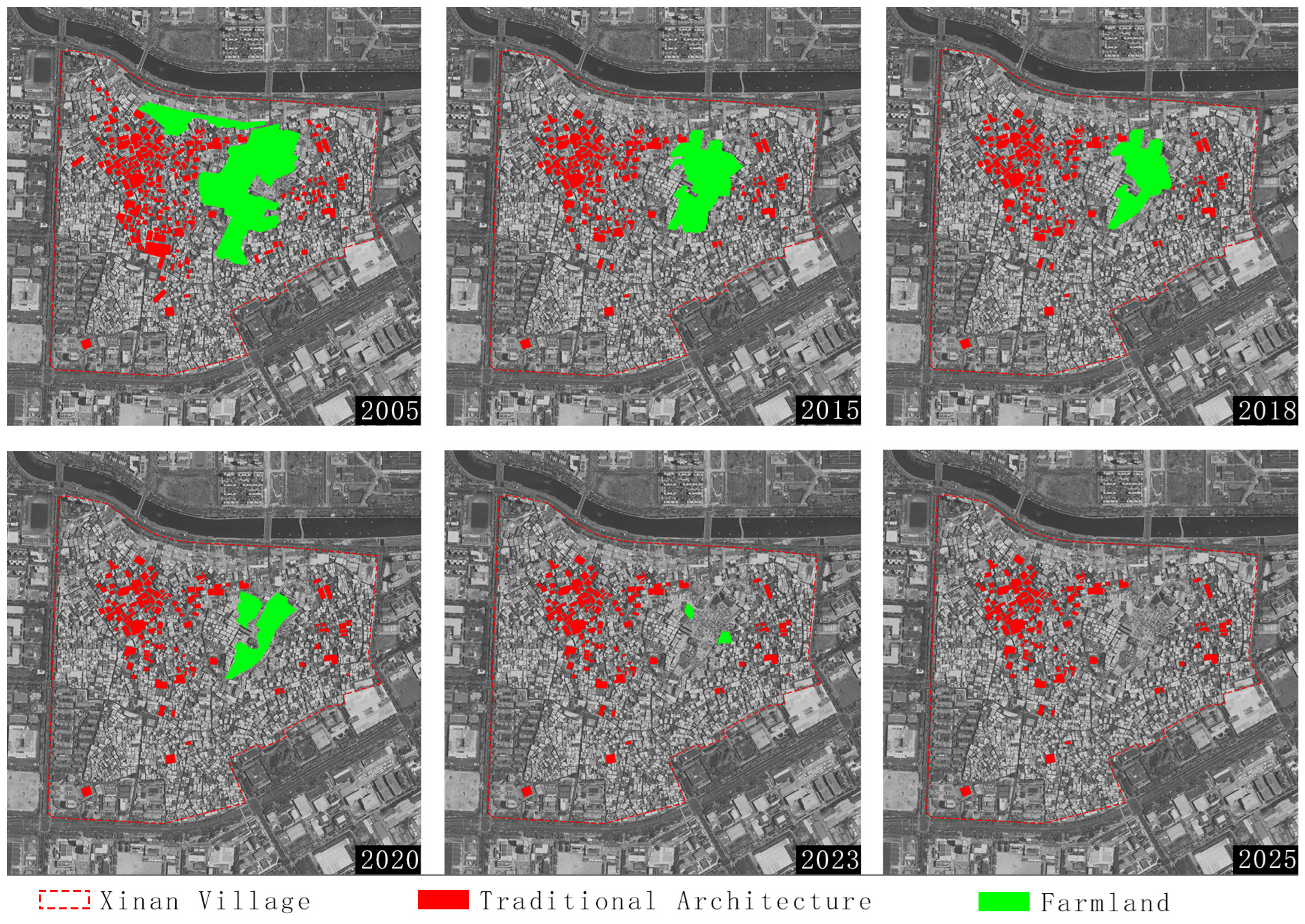
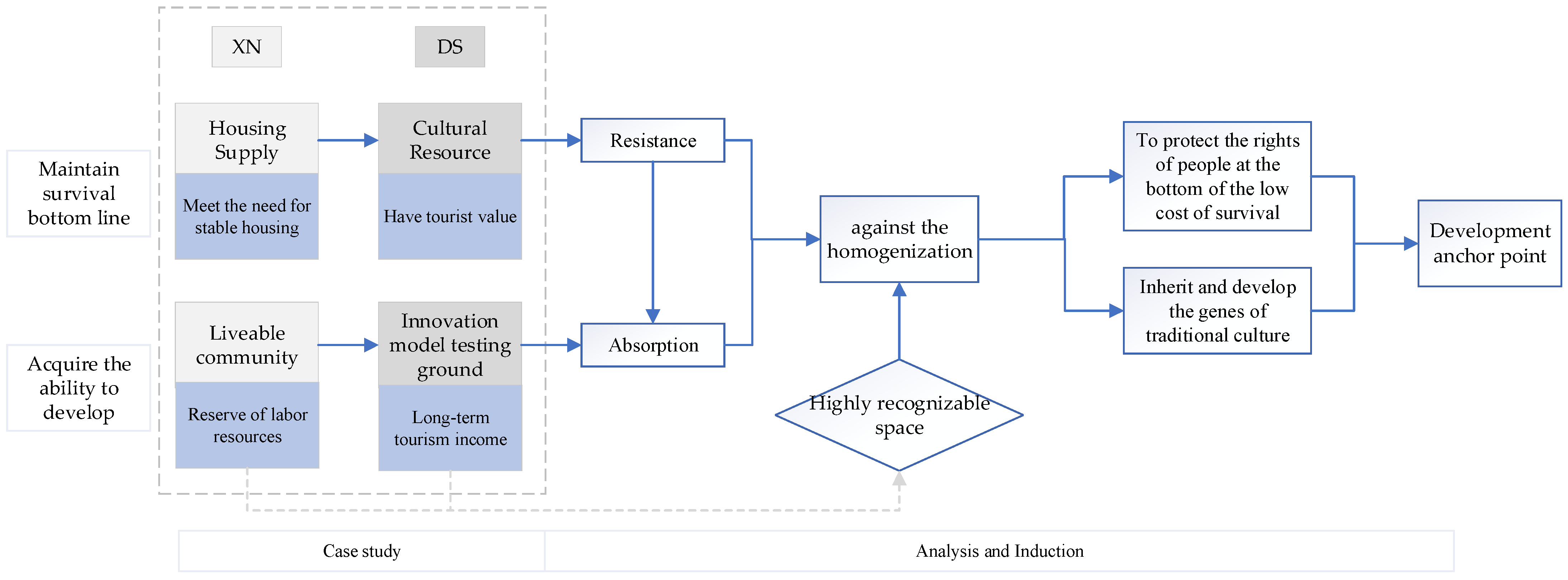
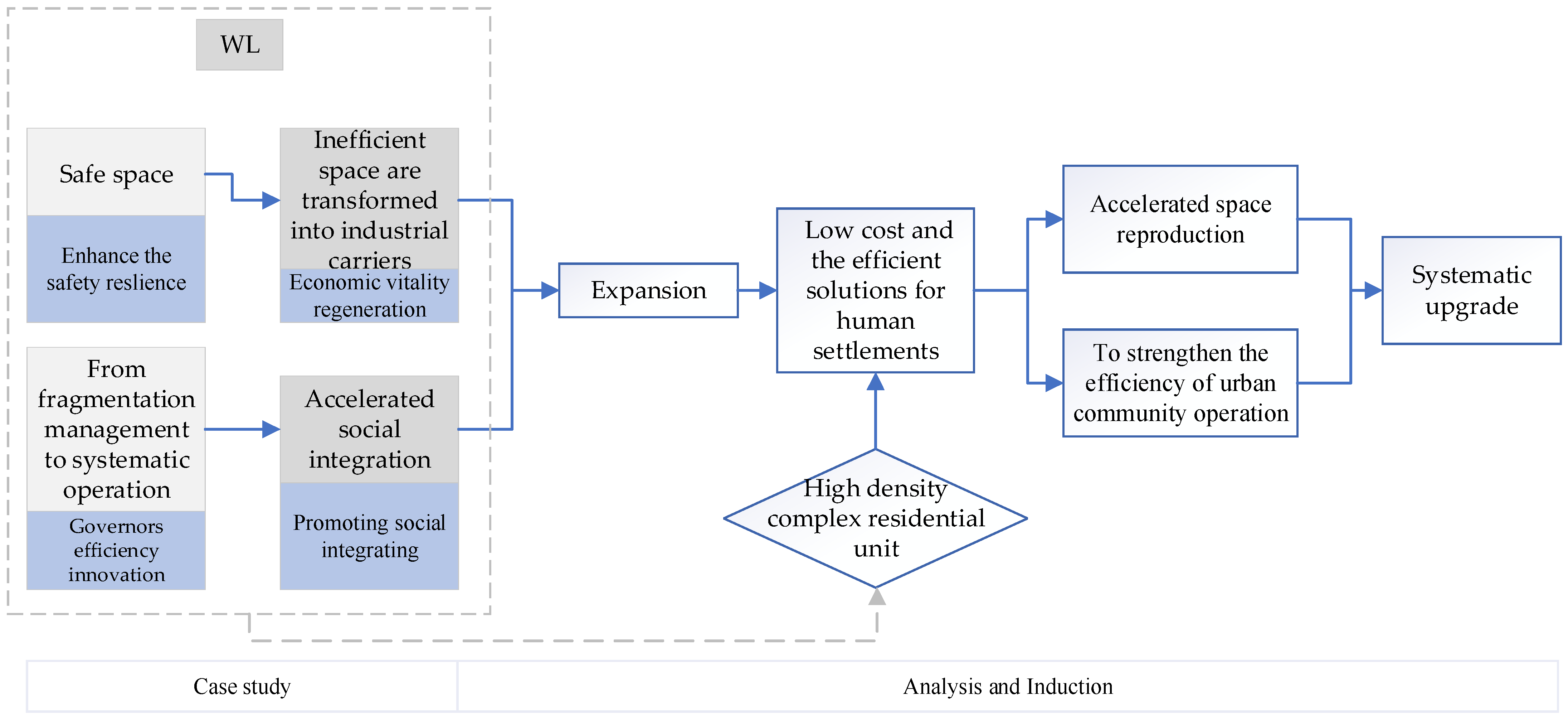
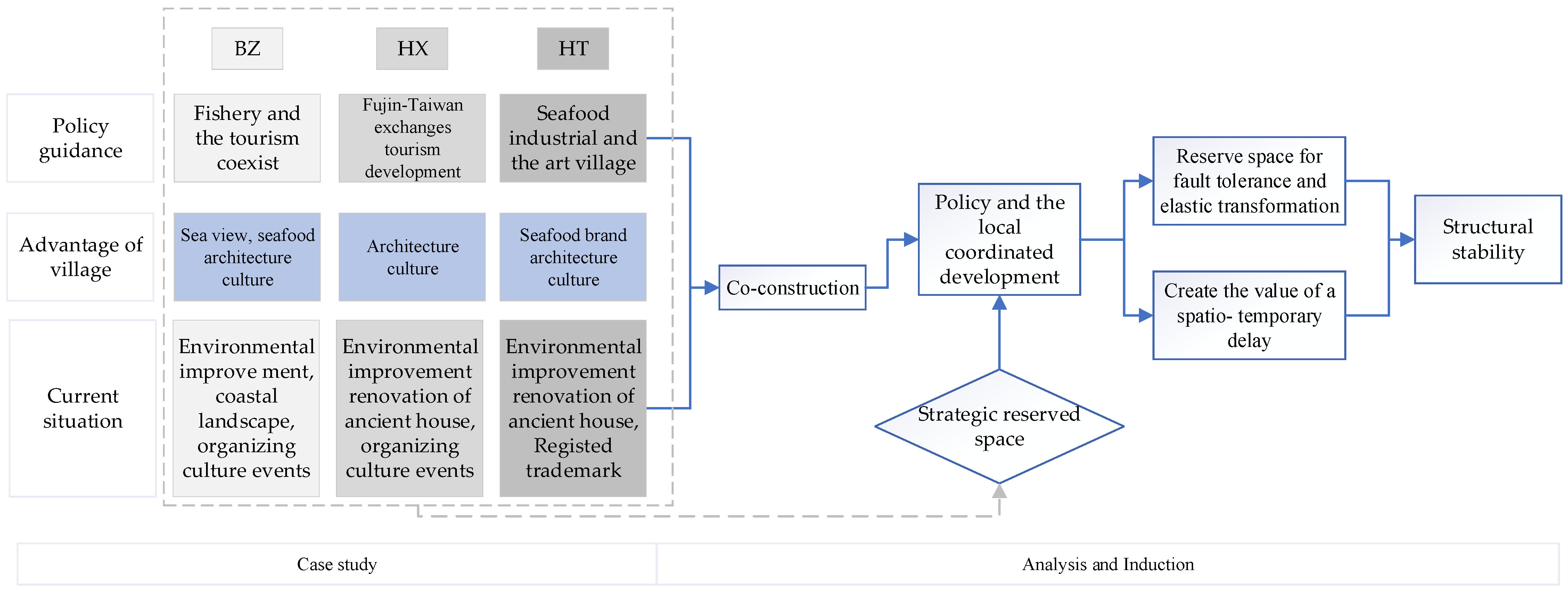
| Coding | Name | Geographical Location | Environmental Description | Population (Ten Thousand) | Area (km2) | Inspection Time |
|---|---|---|---|---|---|---|
| a | Xinan village | Ma Luan Bay | Modern housing coexists with traditional residences. It is close to an industrial area, and the main residents are immigrants. | 10 | 1.4 | March–April 2025 |
| b | Dashe village | Tong An Bay | It is located in the Jimei School Village tourism zone, the main inhabitants of the village are Chen clan people, and it mainly focuses on the development of cultural tourism. | 0.9 | 0.2 | April 2024 April–July 2025 |
| c | Weili Community | Wu Yuan Bay | The overall environment is moving forward toward a modern community, with a large number of migrants and mainly developing the housing rental industry. | 3.75 | 0.8 | May 2025 |
| d | Bingzhou Village | Tong An Bay | It is located in Bingzhou Island, the red cultural village of Xiamen, mainly for local residents, and creates coastal tourism along the bay. | 0.815 | 0.5 | May 2025 |
| e | Houxi Village | Xing Lin Bay | To develop study villages for Fujian and Taiwan cooperation and develop tourism relying on the City God’s Temple culture. | 0.13 | 0.3 | May–June 2025 |
| f | Houtian Village | Tong An Bay | The villagers live near to the Lin family. Currently, some traditional buildings are used as artist studios, and villagers take on experienced seafood professionals as business partners in their industries. | 0.61 | 0.44 | April 2024 May–June 2025 |
| No. | Sample Coding | Gender | Age | Background | Years of Residence | Interview Time |
|---|---|---|---|---|---|---|
| 1 | XA1 | M | 50 | Outsider (Sichuan)—construction worker | 20 | 3 March 2025 |
| 2 | XA2 | M | 60 | Outsider (Sichuan)—construction worker | 20 | 10 March 2025 |
| 3 | XA3 | F | 50 | Outsider (Guizhou)—factory worker | 5 | 10 March 2025 |
| 4 | XA4 | M | 65 | Outsider (Henan)—waste recovery | 15 | 10 March 2025 |
| 5 | XA5 | F | 60 | Outsider (Sichuan) | 20 | 9 April 2025 |
| 6 | XA6 | F | 65 | Outsider (Hubei)—sanitation worker | 20 | 9 April 2025 |
| 7 | XA7 | A: M | 60–70 | Local | / | 9 April 2025 |
| B: F | 60–70 | Local | / | |||
| 8 | XA8 | F | 64 | Outsider (Anhui)—waste recovery | 30 | 9 April 2025 |
| 9 | XA9 | M | 40–50 | Local | / | 9 April 2025 |
| 10 | XA10 | F | 60 | Outsider (Jiangxi)—factory worker | 3–4 | 13 April 2025 |
| 11 | XA11 | M | 70 | Outsider (Sichuan)—factory worker | 16 | 13 April 2025 |
| 12 | XA12 | F | 30 | Outsider (Guizhou) | 3–4 | 13 April 2025 |
| 13 | XA13 | A: M | 50 | Outsider (Sichuan)—construction worker | 15 | 13 April 2025 |
| B: F | 50 | Outsider (Sichuan)—construction worker | 15 | |||
| 14 | XA14 | F | 30 | Local company staff | / | 13 April 2025 |
| 15 | XA15 | F | 66 | Outsider (Guizhou) | 10 | 13 April 2025 |
| 16 | XA16 | F | 60 | Local | / | 13 April 2025 |
| 17 | XA17 | M | 40 | Outsider (Jiangxi)—company staff | 10 | 13 April 2025 |
| 18 | XA18 | F | 50 | Outsider (Fujian) | 8 | 13 April 2025 |
| 19 | XA19 | F | 55 | Outsider (Fujian)—nanny | 5 | 13 April 2025 |
| 20 | XA20 | F | 65 | Outsider (Anhui)—waste recovery | 2 | 13 April 2025 |
| 21 | DS21 | M | 80 | Local | / | 10 April 2024 |
| 22 | DS22 | F | 25 | Outsider (Helongjiang)—clothing shop owner | 2 | 13 April 2024 |
| 23 | DS23 | A: M | 65 | Outsider (Anhui)—restaurant owner | 2–3 | 13 April 2025 |
| B: F | 60 | Outsider (Anhui)—restaurant owner | 2–3 | |||
| 24 | DS24 | F | 25 | Outsider (Henan)—student | / | 13 April 2025 |
| 25 | DS25 | F | 45 | Local (married to DS)—restaurant owner | 10 | 5 July 2025 |
| 26 | DS26 | F | 55 | Local | / | 5 July 2025 |
| 27 | WL27 | A: F | 60–70 | Outsider (Henan) | 2–3 | |
| B: F | 60–70 | Outsider (Henan) | 2–3 | 16 May 2025 | ||
| C: F | 60–70 | Outsider (Henan) | 2–3 | |||
| 28 | WL28 | M | 60 | Outsider (Hubei)—sanitation worker | 20 | 16 May 2025 |
| 29 | WL29 | M | 25 | Outsider (Jiangsu) | 1–2 | 25 June 2025 |
| 30 | BZ30 | M | 65 | Outsider (Anhui1)—waste recovery | 3 | 17 May 2025 |
| 31 | BZ31 | F | 65 | Local | / | 17 May 2025 |
| 32 | HX32 | F | 50–60 | Local | / | 16 May 2025 |
| 33 | HX33 | M | 55 | Local grocery store owner | / | 16 May 2025 |
| 34 | HX34 | F | 40–50 | Building repair worker | 1 | 16 May 2025 |
| 35 | HX35 | M | 35–45 | Local | / | 21 June 2025 |
| 36 | HT36 | M | 35–40 | Initiator of the art project | 9 | 19 April 2024 |
| 37 | HT37 | M | 45–55 | Outsider (Fujian)—construction worker | 5–6 | 5 July 2025 |
| 38 | HT38 | A: M | 60 | Outsider (Hubei)—temporary worker | 1–2 | 5 July 2025 |
| B: F | 60 | Outsider (Hubei) | 1–2 | |||
| 39 | HT39 | M | 75 | Local | / | 5 July 2025 |
| Period | The Main Driver | Regional Case |
|---|---|---|
| 1995–2005 Industrial construction and port expansion | Industrialization development, port expansion, transportation infrastructure | Haicang and Xinglin Taiwan investment zone |
| Wu Yuan Bay Business Center and Park | ||
| The development of Maluan Bay New Town | ||
| 2005–2015 New town construction and ecological restoration | New town construction, industrial upgrading, tourism development | The construction of new towns in Maluan Bay and Jimei |
| Huandong sea area construction coastal romantic line and science and technology city | ||
| Construction of Xiang An Airport | ||
| 2015–2025 Ecological priority and high-quality development | Transportation hubs, layout of emerging industries, ecological compensation | The integration project of industry and city in Maluan Bay New Town |
| The mangrove park restores ecological wetlands |
| Number | Bridge Name | Completion | Purpose and Function | Connection Area |
|---|---|---|---|---|
| 1 | Xiamen Bridge | 1991 | Replace the Gaoji Seawall, Relieve traffic pressure | Xiamen Island—Jimei |
| 2 | Haicang Bridge | 1999 | Relieve traffic pressure, Promote the development of the Haicang Taiwan Business Investment Zone | Xiamen Island—Haicang |
| 3 | Jimei Bridge | 2008 | It connects the eastern part of the island with Jimei New City Support the development of Ring east sea | Xiamen Island—Jimei, Tong An |
| 4 | Xinglin Bridge | 2008 | Reduce pressure on Xiamen Bridge To promote industrial and new town development zones in Xinglin area | Xiamen Island—Xinglin |
| 5 | Xiang An Bridge | 2023 | Improve Xiamen’s eastern transportation network Support the development of Xiang’an Airport and Technology City | Xiamen Island—Xiang An New town |
| 6 | Tong An Bridge | 2007 | Connect Tong An and Xiang An Promote the formation of the economic belt around the Huandong sea area | Tong An Xiang An |
| 7 | Xinyang Bridge | 1996 | Connecting Xinglin and Haicang Promote the development of industry and logistics in Maluan Bay area | Xinglin—Haicang |
| 8 | Xinglin Bay Bridge | 2007 | Promote the joint development of Xinglin bay New Town and Jimei Cultural and Educational District | Inside Jimei New Town |
| 9 | Xinzhou Bridge | 2011 | Promote the joint development of Jimei New Town and Xinglin New Town | Inside Jimei New Town |
| Name | Traditional Architecture | Development Format | Whether to Practice or Not |
|---|---|---|---|
| XA | Ancient houses | Ancient house town | No |
| DS | Ancient houses ancestral hall temples | Catering, home-stay, cultural and creative activities, experience museums | Yes |
| WL | Ancient houses ancestral halls | Tea houses | Yes |
| HX | Ancient houses Ancestral hall temples | Catering, experience centers, museums | Yes |
| HT | Ancient houses ancestral halls | Artist studios | Yes |
| BZ | Folk houses Ancestral hall temples | Historical and cultural streets | No |
Disclaimer/Publisher’s Note: The statements, opinions and data contained in all publications are solely those of the individual author(s) and contributor(s) and not of MDPI and/or the editor(s). MDPI and/or the editor(s) disclaim responsibility for any injury to people or property resulting from any ideas, methods, instructions or products referred to in the content. |
© 2025 by the authors. Licensee MDPI, Basel, Switzerland. This article is an open access article distributed under the terms and conditions of the Creative Commons Attribution (CC BY) license (https://creativecommons.org/licenses/by/4.0/).
Share and Cite
Ding, L.-J.; Lee, S.-H.; Tsai, S.-C. The Healthy City Constructed by Regional Governance and Urban Villages: Exploring the Source of Xiamen’s Resilience and Sustainability. Buildings 2025, 15, 2499. https://doi.org/10.3390/buildings15142499
Ding L-J, Lee S-H, Tsai S-C. The Healthy City Constructed by Regional Governance and Urban Villages: Exploring the Source of Xiamen’s Resilience and Sustainability. Buildings. 2025; 15(14):2499. https://doi.org/10.3390/buildings15142499
Chicago/Turabian StyleDing, Lan-Juan, Su-Hsin Lee, and Shu-Chen Tsai. 2025. "The Healthy City Constructed by Regional Governance and Urban Villages: Exploring the Source of Xiamen’s Resilience and Sustainability" Buildings 15, no. 14: 2499. https://doi.org/10.3390/buildings15142499
APA StyleDing, L.-J., Lee, S.-H., & Tsai, S.-C. (2025). The Healthy City Constructed by Regional Governance and Urban Villages: Exploring the Source of Xiamen’s Resilience and Sustainability. Buildings, 15(14), 2499. https://doi.org/10.3390/buildings15142499








